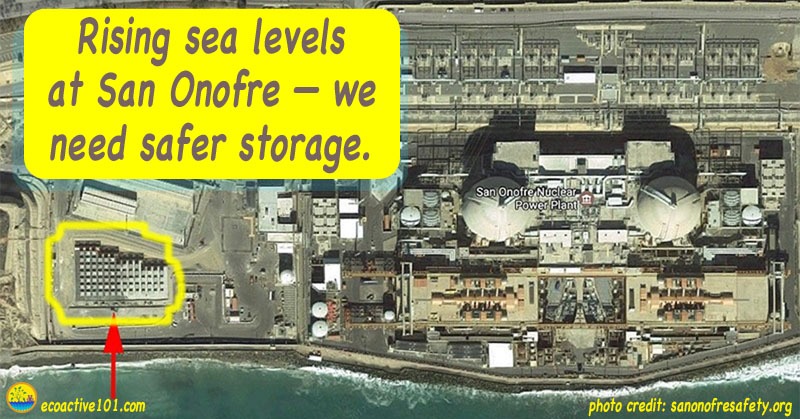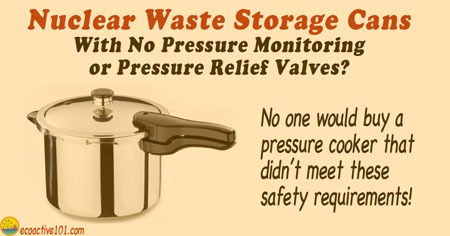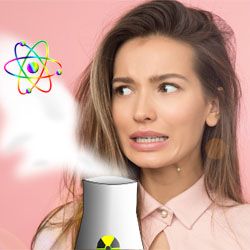You love your family. You’d do just about anything to make sure their lives are not at risk. Right? But … do you have any idea of the risk they’re exposed to by America’s improper and irresponsible nuclear waste storage? Most people do not.
Oh, they may know the government hasn’t yet found an acceptable central storage site. But they’ve read that it’s on the verge of finding one, and then everything will be A-OK.

When I explain that that is nowhere near true, I often see a shield come down over their faces. They do not want to hear any more.
I get it, really I do: radioactive waste—what we used to call “atomic” waste—is scary.
But the problems with nuclear waste storage are real, and they pose serious dangers all over this country. Even in states where there are no nuclear reactors! How can that be? Leaking nuclear waste is blown by the winds, and winds are no resppectors of state lines.
In this article I expose some of the hard-to-face facts about the deplorable status of our collective nuclear waste and suggest steps you can take to change things.
The Facts
FACT: Although people are clamoring to move this highly radioactive waste away from those beaches, lakes and rivers, the thin-walled cans in which the radioactive waste is stored cannot legally or safely be moved—even if we manage to agree on a place to move them to. Why? Because they cannot be inspected for internal microscopic cracks that could lead to radiation leaks. The NRC (Nuclear Regulatory Commission) senior inspector has said it is impossible for these canisters to be inspected according to ASME (American Society of Mechanical Engineers) required code.
FACT: The utility companies that manage our radioactive waste keep telling us it’s safe, nothing to worry about.

FACT: Systems analysts and geologists tell us it is NOT safe, that the radioactive waste needs to be transferred into thick casks so that it can be legally and safely moved away from the beaches, lakes and rivers. And even if the utility companies had a way to inspect their thin-wall cans for cracks, they have no viable plans in place for replacing cracking leaking canisters.
CASE IN POINT: After a hiatus that occurred in response to a whistleblower’s revelation last August of a near-miss 18-foot canister fall at San Onofre Nuclear Generating Station, just south of San Clemente, California, Edison has resumed loading of spent (but still highly radioactive and very hot) fuel rods into the thin-wall canisters.
FACT: The NRC agrees that EVERY can of nuclear waste stored at San Onofre has been damaged by gouging due to a design flaw. As Donna Gilmore, the systems analyst who runs the highly informative website SanOnofreSafety.org, reently pointed out to me, a “gouge” is the beginning of a crack—a wide crack. (The NRC has repeatedly weakened their safety requirements to accommodate shortcomings in the storage and handling of nuclear waste.)
And San Onofre is storing these canisters in a trench 100 feet from a rising ocean and very near a major earthquake fault.

FACT: The NRC recently refused to cite the can manufacturer for their defective design that puts San Onofre out of compliance with their NRC license. And Edison has not indicated any intention of switching to thick-wall casks for safer waste storage. In fact, transfer of waste from the thin-wall cans to thick-wall casks would require a “hot cell,” which Edison has no plans to build.
WARNING: Don’t dismiss this as a southern California problem. The nuclear waste in plants all over the country is stored in similar thin-wall containers, set close to beaches where water levels are likely to rise as climate change progresses. And as cans begin to crack, they become susceptible to water-induced corrosion.

FACT: There are thick-wall casks available that can be legally and safely moved away from the water. So there is a solution—not a forever solution, but one that would buy us the years we so desperately need to seek a more permanent solution.
FACT: Holtec International, manufacturer of the cans in question, has recently gone from being just a container builder and supplier to purchasing decommissioned nuclear plants all around the world. Holtec just purchased the Pilgrim Nuclear Power Plant in Massachusetts.
As one local activist wrote in an email, “[Holtec] will now own and operate the decommissioned Pilgrim NPP, pocket all the public trust funds and provide what? The same kind of shoddy service they are famous for?”
There’s a lot of money in the public trust funds for the company that handles the decommissioning … hmm, I just learned that “Krishna P. Singh, the founder, president and CEO of energy technology firm Holtec International, and wife Martha J. Singh bought a waterfront mansion in Jupiter for $10.5 million.”
FACT: Though SONGS is situated on federal property, Edison is responsible for protecting the public safety until they manage to turn the facility over to another responsible party, presumably the DOE. Or …
QUESTION: What other plants will Holtec be acquiring? The thought that this provider of inadequate storage canisters might be put in control of San Onofre and decisions determining the continued habitability of the southern third of our country (since wind carries our air south and east across the country) is upsetting, to say the least. Yet it could happen—with several billions in public trust funds ending up in Holtec’s pockets.
FACT: As of August 30, 2019, “Public Watchdogs, a nonprofit advocacy group, has requested an immediate court-ordered halt to the transfer of deadly radioactive nuclear waste at the San Onofre Nuclear Generating Station (SONGS) into “thin-walled” dry storage canisters. In the temporary restraining order (TRO) filed with the United States District Court, Public Watchdogs is petitioning the courts to step in and protect the environment and the lives of more than 8 million people who live within the radiation plume zone identified by the Nuclear Regulatory Commission (NRC).”
Will their suit succeed? Let’s hope so. If not, they’ll file another one. But filing suits is expensive, so they’ll need all the help we can give. Charles Langley, Public Watchdogs CEO and Executive Director, says (personal communication) that public outcry is the only reason the court has agreed to hear their case. (OUR case.)
To stay abreast of developments on nuclear waste and other issues affecting the sustainability of life on Planet Earth, join Team GreenSaver. We’ll keep you informed, and together we will plan and execute actions we decide on together to influence decision makers to stand up for US.

FACT: Speaking up makes a difference!
What Can You Do?
You can and should speak up at every opportunity.
- If you live in California or anywhere in the wind path, write to California Governor Gavin Newsom and ask that he protect you and your community by calling a halt to the release of ratepayer funds to Edison until they agree to store all SONGS radioactive nuclear waste in thick-wall casks that have ASME N3 nuclear pressure vessel certificates.
- Write letters to the editor of your local paper.
- Attend community and local government meetings and take a stand.
- Call your elected federal, state and local officials and demand they require replacement of the thin-wall cans being used at our nuclear plants with safer, thick-wall cans.
In short, do the annoying things you’d rather ignore as you go about your daily routine. We cannot afford to leave this to chance.
FACT: By failing to assert yourself publicly on this issue, you make yourself part of the problem.
CONCLUSION: Be part of the solution. Join with other families and individuals working together on Team GreenSaver!
If you live near or in the wind path of a nuclear plant, even if it’s closed down, you have a serious nuclear waste safety problem. Seek out opportunities to publicly demand replacing thin-walled canisters with thick-walled casks.
Once that’s done, we can afford to focus on the next step: finding a permanent storage location for the radioactive nuclear waste.
For a more in-depth analysis of what is happeing across the country with nuclear waste, see https://columbusfreepress.com/article/dark-dawning-age-nuclear-waste-begins.
To your eco-active empowerment,
Chiwah
Eco Activist 🙂 Kids’ Book Author 💡 Editor 😯 Book Formatter 😎 Cover Designer 😀 Publisher
AWriteToKnow.com, PetWrites.com
Email: Info@EcoActive101.com

